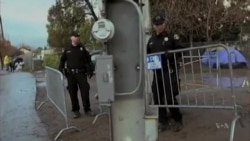Police in San Jose, California, have cleared what was thought to be the largest homeless encampment in the United States. Conditions at the camp, home to as many as 200 people, were unsanitary, authorities said.
The camp cleared Thursday was situated in the heart of Silicon Valley, the prosperous high tech center of the United States. But such camps exist all over the country, some of them purposefully less visible.
The numbers aren't exact, but the U.S. government says hundreds of thousands of people are homeless on any given day. The reasons why are also hard to pin down but include a lack of affordable housing, poverty, mental illness and unemployment.
In Los Angeles, outreach workers from the group People Assisting the Homeless drive along concrete flood channels and freeways to look for homeless camps. On a recent trip, they stopped and gave Lucy, a homeless woman in one small camp, some water and snacks.
Lucy, 53, said the homeless like to live near friends and neighbors, like everyone else. She pointed to a dozen makeshift structures, made of scrap wood and plastic tarps, across the flood channel.
“A lot of us try to team up, two and two," she said. "They help each other.”
'Doing their thing'
Outreach worker Jorge Guzman said the homeless set up camps where they are hidden from view, behind industrial buildings or bushes.
“They just don’t want to be noticed," he said. "They’re doing their thing out there, and they’re just trying to survive.”
Municipal workers periodically clear the underbrush, exposing homeless campers. But one woman near the city of Whittier, California, said she'd lived in her camp for six years.
Sarah Sindeldecker and her husband live between a busy freeway and the river. They're sometimes forced to move, but don’t go far.
“When they kick you out, you have to find another place," she said. "We’ve gone to the (nearby) Telegraph Bridge for six months, and then move back here when they cleaned us out. They have to clean out every once in a while.”
Further north, in the city of Santa Clarita, homeless resident Michael Crosby was coping with rain at his campsite.
“It’s clean and tidy, except for lately when this storm came in," he said. "I spent most of the night covering up stuff, trying to salvage what we can, and stay dry.”
The nearby river fills with winter rains, threatening his belongings. “If any more comes down at a higher rate, it’s going to fork off and wash us away,” Crosby said.
Crosby will be safe from the rain for the next three months. He was given a cot and meals at a winter emergency shelter from the charity Bridge to Home.
Hard choices
Executive Director Tim Davis said the homeless face hard choices. “(Whether from) bad luck, or you have a mental disease, or you have drug or alcohol problems, and you do make $10 an hour, you can’t find a place to live around here," he said. "So your choice is, if you have a car, live in your car, or you live in the open.”
Outreach workers in Whittier try to get people off the streets and into housing. Although many receive small government subsidies, housing is too expensive. Still, with help from social agencies, outreach worker Tomasz Babiszkiewizc says, there are successes.
“It is really good to see the steps (progress) where people are leaving their encampments and transitioning to either transitional housing, and after when they obtain their own housing,” he said.
For now, many remain on the streets and in their makeshift camps, moving when they have to as their campsites are dismantled.











